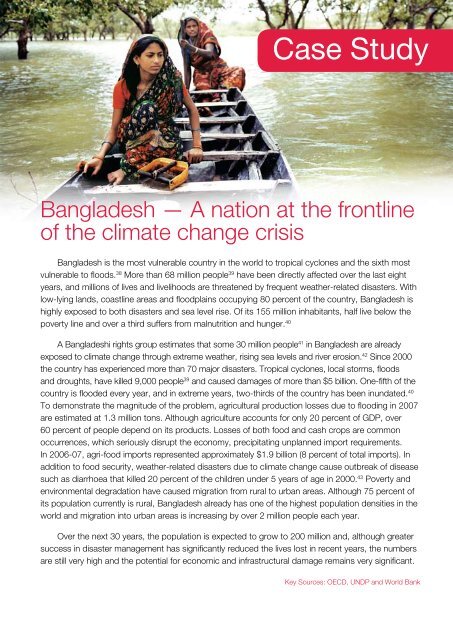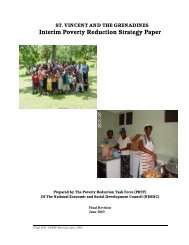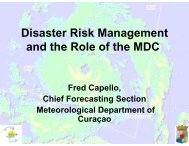The Anatomy of A Silent Crisis The Anatomy of A Silent Crisis
The Anatomy of A Silent Crisis The Anatomy of A Silent Crisis
The Anatomy of A Silent Crisis The Anatomy of A Silent Crisis
- TAGS
- anatomy
- www.bb.undp.org
Create successful ePaper yourself
Turn your PDF publications into a flip-book with our unique Google optimized e-Paper software.
Case Study<br />
Bangladesh — A nation at the frontline<br />
<strong>of</strong> the climate change crisis<br />
Bangladesh is the most vulnerable country in the world to tropical cyclones and the sixth most<br />
vulnerable to floods. 38 More than 68 million people 39 have been directly affected over the last eight<br />
years, and millions <strong>of</strong> lives and livelihoods are threatened by frequent weather-related disasters. With<br />
low-lying lands, coastline areas and floodplains occupying 80 percent <strong>of</strong> the country, Bangladesh is<br />
highly exposed to both disasters and sea level rise. Of its 155 million inhabitants, half live below the<br />
poverty line and over a third suffers from malnutrition and hunger. 40<br />
A Bangladeshi rights group estimates that some 30 million people 41 in Bangladesh are already<br />
exposed to climate change through extreme weather, rising sea levels and river erosion. 42 Since 2000<br />
the country has experienced more than 70 major disasters. Tropical cyclones, local storms, floods<br />
and droughts, have killed 9,000 people 39 and caused damages <strong>of</strong> more than $5 billion. One-fifth <strong>of</strong> the<br />
country is flooded every year, and in extreme years, two-thirds <strong>of</strong> the country has been inundated. 40<br />
To demonstrate the magnitude <strong>of</strong> the problem, agricultural production losses due to flooding in 2007<br />
are estimated at 1.3 million tons. Although agriculture accounts for only 20 percent <strong>of</strong> GDP, over<br />
60 percent <strong>of</strong> people depend on its products. Losses <strong>of</strong> both food and cash crops are common<br />
occurrences, which seriously disrupt the economy, precipitating unplanned import requirements.<br />
In 2006-07, agri-food imports represented approximately $1.9 billion (8 percent <strong>of</strong> total imports). In<br />
addition to food security, weather-related disasters due to climate change cause outbreak <strong>of</strong> disease<br />
such as diarrhoea that killed 20 percent <strong>of</strong> the children under 5 years <strong>of</strong> age in 2000. 43 Poverty and<br />
environmental degradation have caused migration from rural to urban areas. Although 75 percent <strong>of</strong><br />
its population currently is rural, Bangladesh already has one <strong>of</strong> the highest population densities in the<br />
world and migration into urban areas is increasing by over 2 million people each year.<br />
Over the next 30 years, the population is expected to grow to 200 million and, although greater<br />
success in disaster management has significantly reduced the lives lost in recent years, the numbers<br />
are still very high and the potential for economic and infrastructural damage remains very significant.<br />
Key Sources: OECD, UNDP and World Bank







